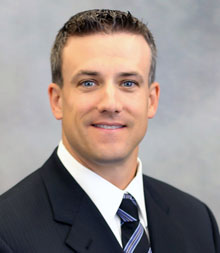
Message from your doctor…
Whether you or one of your family members or friends is considering clavicle fracture ORIF, or are scheduled for surgery, I understand this can be a stressful time. And you may have forgotten some of the information we discussed during our last visit, or forgot to ask me a specific question about what to expect. This site is designed to help us stay connected, and to answer some of the most common questions patients ask me about clavicle surgery.
I want to make sure that both you and your family members have timely information at your fingertips during the days, weeks, and months following your surgery…so you can get back to enjoying the activities you love.
MOST COMMON QUESTIONS
Clavicle Fracture ORIF
How should I be using my sling?
The sling should be worn at all times when you are up and walking around. While you are sitting/resting, you may remove the sling occasionally as long as your upper arm/shoulder stays near your body. Typically the sling will be worn for 2-3 weeks total.
What motions should I avoid?
You should avoid reaching overhead/behind your back until you are progressed to this point in physical therapy. While the plate and screws are providing a secure repair for your fracture, your body still must heal the fracture for this surgery to be successful. Please don’t do heavy lifting until you are progressed by your surgeon and physical therapist.
When can I drive?
You may drive once you feel comfortable moving the shoulder without pain and you are not taking any narcotic pain medications. You should not wear a sling while driving. Most patients should wait 2-4 weeks to drive.
How should I be sleeping?
Please try to wear the sling while you are sleeping for at least a few nights, for comfort. Sometimes it is more comfortable to sleep upright (in a recliner chair) for a few days to weeks after surgery- this is optional.
Should I be taking supplements for my fracture healing?
Yes, we recommend a healthy diet and daily recommended vitamins and minerals to support your overall health and bone healing.
Please visit http://orthoinfo.aaos.org/topic.cfm?topic=A00317 for specifics about calcium and vitamin D supplements.
*Please check with your medical doctor if you have underlying health conditions/if you are supposed to limit calcium/vitamin D
SPORTS SPECIFICS
We know you are eager to return to your sports and hobbies. We want to guide you safely through that process. Please use the following as a guide.
GOLF
2 weeks post-op: Putting
2-3 months post-op: If you have full and comfortable motion, you may take full swings with your irons
3-6 months post-op: You may progress to your driver/full play as tolerated
BASKETBALL
1 month post-op: jogging, non-contact drills, light shooting
2-3 months post op: start contact drills based on fracture healing (Dr. Sostak will discuss)
3-4 months post op: No restrictions based on return of full motion/strength and full fracture healing
SOCCER
1 month post-op: jogging, non-contact drills, light shooting
2-3 months post op: start contact drills based on fracture healing (Dr. Sostak will discuss)
3-4 months post op: No restrictions based on return of full motion/strength and full fracture healing
FOOTBALL
1 month post-op: jogging, non-contact drills, light shooting
9-10 weeks post op: start contact drills based on fracture healing (Dr. Sostak will discuss)
10-12 weeks post op: No restrictions based on return of full motion/strength and full fracture healing
BASEBALL/SOFTBALL
1 month post-op: jogging, non-contact drills, light shooting
8-10 weeks post op: start contact drills and hitting based on fracture healing (Dr. Sostak will discuss)
10-12 weeks post op: No restrictions based on return of full motion/strength and full fracture healing
SWIMMING
1 month post op: Once your incision is well healed, you may get into a pool. You may progress swimming as tolerated- ensure you have good shoulder motion before you attempt swimming.
WEIGHT LIFTING
1 week post op: You may do lower body and core exercises as tolerated.
Please follow the instructions of your physical therapist for upper body exercise. Once you are nearing the end of physical therapy (typically 3 months post-op), your therapist can create a safe “return-to-lifting” program. Physical Therapists and can outline a specific plan for you.



